Pore Structure and Fractal Characteristics of Different Shale Lithofacies in the Dalong Formation in the Western Area of the Lower Yangtze Platform
Abstract
1. Introduction
2. Geological Setting
3. Samples and Methods
4. Results
4.1. Organic Geochemistry
4.2. Mineral Compositions and Lithofacies Division
4.3. N2 Adsorption–Desorption Isotherm Characteristics
4.3.1. Adsorption Isotherms Types and Their Implications for PSD
4.3.2. Hysteresis Loops and Reflections on Shale Pore Shapes and Types
4.4. Pore Structure Parameters
4.4.1. Pore Volume (PV) and Surface Area (SA)
4.4.2. Pore Size Distribution (PSD)
4.5. FHH Fractal Dimensions
5. Discussion
5.1. Relationships between TOC and Clay Minerals and Quartz
5.2. Relationships among Pore Structure Parameters
5.3. Relationships between Mineral Compositions and SA, PV
5.4. Relationships between Mineral Compositions and Fractal Dimensions
6. Conclusions
Author Contributions
Funding
Acknowledgments
Conflicts of Interest
References
- Curtis, J.B. Fractured shale-gas systems. AAPG Bull. 2002, 86, 1921–1938. [Google Scholar]
- Jarvie, D.M.; Hill, R.J.; Ruble, T.E.; Pollastro, R.M. Unconventional shale-gas systems: The Mississippian Barnett Shale of north-central Texas as one model for thermogenic shale-gas assessment. AAPG Bull. 2007, 91, 475–499. [Google Scholar] [CrossRef]
- Ross, D.J.K.; Bustin, R.M. The importance of shale composition and pore structure upon gas storage potential of shale gas reservoirs. Mar. Pet. Geol. 2009, 26, 916–927. [Google Scholar] [CrossRef]
- Zhang, T.; Ellis, G.S.; Ruppel, S.C.; Milliken, K.; Yang, R. Effect of organic-matter type and thermal maturity on methane adsorption in shale-gas systems. Org. Geochem. 2012, 47, 120–131. [Google Scholar] [CrossRef]
- Ji, L.; Zhang, T.; Milliken, K.; Qu, J.; Zhang, X. Experimental investigation of main controls to methane adsorption in clay-rich rocks. Appl. Geochem. 2012, 27, 2533–2545. [Google Scholar] [CrossRef]
- Chen, S.; Zhu, Y.; Wang, H.; Liu, H.; Wei, W.; Fang, J. Shale gas reservoir characterisation: A typical case in the southern Sichuan Basin of China. Energy 2011, 36, 6609–6616. [Google Scholar] [CrossRef]
- Hu, Q.; Gao, X.; Gao, Z.; Ewing, R.; Dultz, S.; Kaufmann, J. American Association of Petroleum Geologists Unconventional Resources Technology Conference. In Proceedings of the 2nd Unconventional Resources Technology Conference-Pore Accessibility and Connectivity of Mineral and Kerogen Phases for Shales, Denver, CO, USA, 24–27 August 2014. [Google Scholar]
- Loucks, R.G.; Reed, R.M.; Ruppel, S.C.; Jarvie, D.M. Morphology, genesis, and distribution of nanometer-scale pores in siliceous mudstones of the Mississippian Barnett shale. J. Sediment. Res. 2009, 79, 848–861. [Google Scholar] [CrossRef]
- Milliken, K.L.; Reed, R.M. Multiple causes of diagenetic fabric anisotropy in weakly consolidated mud, Nankai accretionary prism, IODP Expedition 316. J. Struct. Geol. 2010, 32, 1887–1898. [Google Scholar] [CrossRef]
- Slatt, R.M.; O’Brien, N.R. Pore types in the Barnett and Woodford gas shales: Contribution to understanding gas storage and migration pathways in fine-grained rocks. AAPG Bull. 2011, 95, 2017–2030. [Google Scholar] [CrossRef]
- Chalmers, G.R.; Bustin, R.M.; Power, I.M. Characterization of gas shale pore systems by porosimetry, pycnometry, surface area, and field emission scanning electron microscopy/transmission electron microscopy image analyses: Examples from the Barnett, Woodford, Haynesville, Marcellus, and Doig units. AAPG Bull. 2012, 96, 1099–1119. [Google Scholar]
- Keller, L.M.; Schuetz, P.; Erni, R.; Rossell, M.D.; Lucas, F.; Gasser, P.; Holzer, L. Characterization of multi-scale microstructural features in Opalinus Clay. Microporous Mesoporous Mater. 2013, 170, 83–94. [Google Scholar] [CrossRef]
- Clarkson, C.R.; Freeman, M.; He, L.; Agamalian, M.; Melnichenkom, Y.B.; Mastalerz, M.; Bustin, R.M.; Radliński, A.P.; Blach, T.P. Characterization of tight gas reservoir pore structure using USANS/SANS and gas adsorption analysis. Fuel 2012, 95, 371–385. [Google Scholar] [CrossRef]
- Clarkson, C.R.; Solano, N.R.; Bustin, R.M.; Bustin, A.M.M.; Blach, T.P. Pore structure characterization of North American shale gas reservoirs using USANS/SANS, gas adsorption, and mercury intrusio. Fuel 2013, 103, 606–616. [Google Scholar] [CrossRef]
- Labani, M.M.; Rezaee, R.; Saeedi, A.; Hinai, A.A. Evaluation of pore size spectrum of gas shale reservoirs using low pressure nitrogen adsorption, gas expansion and mercury porosimetry: A case study from the Perth and Canning Basins, Western Australia. J. Pet. Sci. Eng. 2013, 112, 7–16. [Google Scholar] [CrossRef]
- Tian, H.; Pan, L.; Xiao, X.; Wikins, R.W.T.; Meng, Z.; Huang, B. A preliminary study on the pore characterization of Lower Silurian black shales in the Chuandong Thrust Fold Belt, southwestern China using low pressure N2 adsorption and FE-SEM methods. Mar. Pet. Geol. 2013, 48, 8–19. [Google Scholar] [CrossRef]
- Tian, H.; Pan, L.; Zhang, T.; Xiao, X.; Meng, Z.; Huang, B. Pore characterization of organic-rich Lower Cambrian shales in Qiannan Depression of Guizhou Province, Southwestern China. Mar. Pet. Geol. 2015, 62, 28–43. [Google Scholar] [CrossRef]
- Wang, Y.M.; Dong, D.Z.; Yang, H.; He, L.; Wang, S.Q.; Huang, J.L.; Pu, B.L.; Wang, S.F. Quantitative characterization of reservoir space in the Lower Silurian Longmaxi Shale, southern Sichuan, China. Sci. China Earth Sci. 2014, 57, 313–322. [Google Scholar] [CrossRef]
- Cao, T.; Song, Z.; Wang, S.; Cao, X.; Li, Y.; Xia, J. Characterizing the pore structure in the Silurian and Permian shales of the Sichuan Basin, China. Mar. Pet. Geol. 2015, 61, 140–150. [Google Scholar] [CrossRef]
- Liu, X.; Xiong, J.; Liang, L. Investigation of pore structure and fractal characteristics of organic-rich Yanchang formation shale in central China by nitrogen adsorption/desorption analysis. J. Nat. Gas Sci. Eng. 2015, 22, 62–72. [Google Scholar] [CrossRef]
- Huang, S.J.; Yu, Y.C.; Lee, T.Y.; Lu, T.S. Correlations and characterization of porous solids by fractal dimension and porosity. Physica A 1999, 274, 419–432. [Google Scholar] [CrossRef]
- Yu, B.; Ping, C. A fractal permeability model for bi-dispersed porous media. Int. J. Heat Mass Transf. 2002, 45, 2983–2993. [Google Scholar] [CrossRef]
- Bird, N.; Díaz, M.C.; Saa, A.; Tarquis, A.M. Fractal and multifractal analysis of pore-scale images of soil. J. Hydrol. 2006, 322, 211–219. [Google Scholar] [CrossRef]
- Zhang, S.; Tang, S.; Tang, D.; Huang, W.; Pan, Z. Determining fractal dimensions of coal pores by FHH model: Problems and effects. J. Nat. Gas Sci. Eng. 2014, 21, 929–939. [Google Scholar] [CrossRef]
- Liang, L.; Xiong, J.; Liu, X. An investigation of the fractal characteristics of the Upper Ordovician Wufeng Formation shale using nitrogen adsorption analysis. J. Nat. Gas Sci. Eng. 2015, 27, 402–409. [Google Scholar] [CrossRef]
- Yang, C.; Zhang, J.; Wang, X.; Tang, X.; Chen, Y.; Jiang, L.; Gong, X. Nanoscale pore structure and fractal characteristics of a marine-continental transitional shale: A case study from the lower Permian Shanxi Shale in the southeastern Ordos Basin, China. Mar. Pet. Geol. 2017, 88, 54–68. [Google Scholar] [CrossRef]
- Avnir, D.; Jaroniec, M. An isotherm equation for adsorption on fractal surfaces of heterogeneous porous materials. Langmuir 1989, 5, 1431–1433. [Google Scholar] [CrossRef]
- Loucks, R.G.; Reed, R.M.; Ruppel, S.C.; Hammes, U. Spectrum of pore types and networks in mudrocks and a descriptive classification for matrix-related mudrock pores. AAPG Bull. 2012, 96, 1071–1098. [Google Scholar] [CrossRef]
- Bernard, S.; Horsfield, B.; Schulz, H.M.; Wirth, R.; Schreiber, A.; Sherwood, N. Geochemical evolution of organic-rich shales with increasing maturity: A STXM and TEM study of the Posidonia Shale (Lower Toarcian, northern Germany). Mar. Pet. Geol. 2012, 31, 70–89. [Google Scholar] [CrossRef]
- Curtis, M.E.; Cardott, B.J.; Songdergeld, C.H.; Rai, C.S. Development of organic porosity in the Woodford Shale with increasing thermal maturity. Int. J. Coal Geol. 2012, 103, 26–31. [Google Scholar] [CrossRef]
- Milliken, K.L.; Rudnicki, M.; Awwiller, D.N.; Zhang, T. Organic matter-hosted pore system, Marcellus Formation (Devonian), Pennsylvania. AAPG Bull. 2013, 97, 177–200. [Google Scholar] [CrossRef]
- Kuila, U.; McCarty, D.K.; Derkowski, A.; Fischer, T.B.; Topór, T.; Prasad, M. Nano-scale texture and porosity of organic matter and clay minerals in organic-rich mudrocks. Fuel 2014, 135, 359–373. [Google Scholar] [CrossRef]
- Yang, C.; Zhang, J.; Tang, X.; Ding, J.; Zhao, Q.; Dang, W.; Chen, H.; Su, Y.; Li, B.; Lu, D. Comparative study on micro-pore structure of marine, terrestrial, and transitional shales in key areas, China. Int. J. Coal Geol. 2017, 171, 76–92. [Google Scholar] [CrossRef]
- Nie, H.; Tang, X.; Bian, R. Controlling factors for shale gas accumulation and prediction of potential development area in shale gas reservoir of South China. Acta Pet. Sin. 2009, 30, 484–491. [Google Scholar]
- Zou, C.; Dong, D.; Wang, S.; Li, J.; Li, X.; Wang, Y.; Li, D.; Cheng, K. Geological characteristics, formation mechanism and resource potential of shale gas in China. Pet. Explor. Dev. 2010, 37, 641–653. [Google Scholar] [CrossRef]
- Guo, S.; Huang, L. Gas-bearing influential factors and evaluation of shale gas reservoir: A case study of Paleozoic shale gas reservoir in upper Yangtze region. Pet. Geol. Exp. 2013, 35, 601–606. [Google Scholar]
- Wu, H. The Gelogical Conditions and Exploration Prospect of Paleozoic Shale in Lower Yangtz Area, Anhui; Nanjing University: Nanjing, China, 2014. [Google Scholar]
- Song, T.; Lin, T.; Chen, K.; Meng, F.; Li, H.; Wang, P. The discovery of shale gas in Upper Permian transitional facies at Jingye-1 well in Lower Yangtze region. Geol. China 2017, 44, 606–607. [Google Scholar]
- Shi, G.; Huang, Z.; Zheng, H.; Xu, Z.; Zhao, M.; Shao, W.; Yin, Q.; Zhou, D.; Fang, C.; Teng, L.; et al. Drilling discovery of “Three Gas One Oil” in the Permian strata of Lower Yangtze area. Geol. China 2018, 45, 416–417. [Google Scholar]
- Zhu, G.; Xu, J.; Liu, G. Tectonic pattern and dynamic mechanism of the foreland deformation in the lower yangtze region. Reg. Geol. China 1999, 1, 74–80. [Google Scholar]
- Ye, Z.; Ma, L.; Liang, X.; Wu, G.; Xu, K.; Zhang, T. The independent Lower Yangtze block and Mesozo icreformed residual basins. Chin. J. Geol. 2006, 1, 81–101. [Google Scholar]
- SY-T 5125-2014. Identification and Classification of Microscopic Components of Kerogen through Transmission Light-Fluorescence; China National Petroleum Corporation: Beijing, China, 2014. [Google Scholar]
- GB/T 19145-2003. Method for Determination of Total Organic Carbon in Sedimentary Rocks; General Administration of Quality Supervision, Inspection and Quarantine of the People’s Republic of China: Beijing, China, 2003.
- SY-T 5124-2012. Method for Determination of Vitrinite Reflectance in Sedimentary Rocks; China National Petroleum Corporation: Beijing, China, 2012. [Google Scholar]
- SY-T 5163-2018. Methods of X-ray Diffraction Analysis of Clay minerals and Common Non-Clay Minerals in Sedimentary Rocks; China National Petroleum Corporation: Beijing, China, 2018. [Google Scholar]
- SY-T 6154-1995. Determination of Rock Specific Surface and Pore Diameter Distribution: Static Nitrogen Adsorption Capacity Method; China National Petroleum Corporation: Beijing, China, 1995. [Google Scholar]
- Brunauer, S.; Emmett, P.H.; Teller, E. Adsorption of gases in multimolecular layers. J. Am. Chem. Soc. 1938, 60, 309–319. [Google Scholar] [CrossRef]
- Barrett, E.P.; Joyner, L.G.; Halenda, P.P. The determination of pore volume and area distributions in porous substances. Computations from nitrogen isotherms. J. Am. Chem. Soc. 1951, 73, 373–380. [Google Scholar]
- Xu, L.; Zhang, D.; Xian, X. Fractal dimensions of coals and cokes. J. Colloid Interface Sci. 1997, 190, 357–359. [Google Scholar] [CrossRef] [PubMed]
- Chen, K.L.; Zhang, T.S.; Liang, X.; Zhang, Z.; Wang, G.G. Analysis of shale lithofacies and sedimentary environment on Wufeng Formation lower Longmaxi Formation in Dianqianbei depression. Acta Sedimentol. Sin. 2018, 36, 743–755. [Google Scholar]
- Wang, Y.; Wang, S.; Dong, D.; Li, X.; Huang, J.; Zhang, C.; Guan, Q. Lithofacies characterization of Longmaxi Formation of the Lower Silurian, southern Sichuan. Earth Sci. Front. 2016, 23, 119–133. [Google Scholar]
- Rouquerol, J.; Avnir, D.; Fairbridge, C.W.; Everett, D.H.; Haynes, J.H.; Pernicone, N.; Ransay, J.D.F.; Sing, K.S.W.; Unger, K.K. Recommendations for the characterization of porous solids (Technical Report). Pure Appl. Chem. 1994, 66, 1739–1758. [Google Scholar] [CrossRef]
- Sing, K.S.W.; Everett, D.H.; Haul, R.A.W.; Moscou, L.; Pierotti, R.A.; Rouquerol, J.; Siemieniewska, T. Reporting physisorption data for gas/solid systems with special reference to the determination of surface area and porosity. Pure Appl. Chem. 1985, 57, 603–619. [Google Scholar] [CrossRef]
- Milner, M.; Mclin, R.; Peteriello, J.; Tek, T. Imaging texture and porosity in mudstones and shales: Comparison of secondary and ion-milled backscatter SEM methods. In Proceedings of the Canadian Unconventional Resources and International Petroleum Conference, Calgary, AB, Canada, 19–21 October 2010. [Google Scholar]
- Kuila, U.; Prasad, M. Specific surface area and pore-size distribution in clays and shales. Geophys. Prospect. 2013, 61, 341–362. [Google Scholar] [CrossRef]
- Yang, C.; Zhang, J.; Han, S.; Wang, X.; Wang, L.; Yu, W.; Wang, Z. Compositional controls on pore-size distribution by nitrogen adsorption technique in the Lower Permian Shanxi Shales, Ordos Basin. J. Nat. Gas Sci. Eng. 2016, 34, 1369–1381. [Google Scholar] [CrossRef]
- Xu, Y.; Lu, C.; Chen, G.; Zhong, J.; Yang, W.; Xue, L. Fractal characteristics of shale pores of Longmaxi Formation in southeast Sichuan Basin. Lithol. Reserv. 2015, 27, 32–39. [Google Scholar]
- Zhang, P.; Huang, Y.; Zhang, J.; Liu, H.; Yang, J. Fractal characteristics of the Longtan formation transitional shale in northwest Guizhou. J. China Coal Soc. 2018, 43, 1580–1588. [Google Scholar]
- Dang, W.; Zhang, J.; Wei, X.; Tang, X.; Chen, Q.; Li, Z.; Zhang, M.; Liu, J. Geological controls on methane adsorption capacity of Lower Permian transitional black shales in the Southern North China Basin, Central China: Experimental results and geological implications. J. Pet. Sci. Eng. 2017, 152, 456–470. [Google Scholar] [CrossRef]
- Dathe, A.; Eins, S.; Niemeyer, J.; Gerold, G. The surface fractal dimension of the soil–pore interface as measured by image analysis. Geoderma 2001, 103, 203–229. [Google Scholar] [CrossRef]
- Rigby, S.P. Predicting surface diffusivities of molecules from equilibrium adsorption isotherms. Colloids Surf. A (Physicochem. Eng. Asp.) 2005, 262, 139–149. [Google Scholar] [CrossRef]
- Xie, D.; Guo, Y.; Zhao, D. Fractal characteristics of adsorption pore of shale based on low temperature nitrogen experiment. J. China Coal Soc. 2014, 39, 2466–2472. [Google Scholar]
- Jaroniec, M. Evaluation of the fractal dimension from a single adsorption isotherm. Langmuir 1995, 11, 2316–2317. [Google Scholar] [CrossRef]
- Qin, J.; Fu, X.; Shen, B.; Liu, W.; Teng, G.; Zhang, Q.; Jiang, Q. Characteristics of ultramicroscopic organic lithology of excellent marine shale in the upper Permian sequence, Sichuan Basin. Pet. Geol. Exp. 2010, 32, 164–170. [Google Scholar]
- Liu, S.G.; Ma, W.X.; Jansa, L.; Huang, W.M.; Zeng, X.L.; Zahng, C.J. Characteristics of the shale gas reservoir rocks in the Lower Silurian Longmaxi Formation, East Sichuan Basin, China. Acta Petrol. Sin. 2011, 27, 2239–2252. [Google Scholar] [CrossRef]
- Ding, J.; Zhang, J.; Tang, X.; Huo, Z.; Han, S.; Lang, Y.; Zheng, Y.; Li, X.; Liu, T. Elemental geochemical evidence for depositional conditions and organic matter enrichment of black rock series strata in an inter-platform basin: The Lower Carboniferous Datang Formation, Southern Guizhou, Southwest China. Minerals 2018, 8, 509. [Google Scholar] [CrossRef]
- Dong, D.; Cheng, K.; Wang, Y.; Li, X.; Wang, S.; Huang, J. Forming conditions and characteristics of shale gas in the Lower Paleozoic of the Upper Yangtze region, China. Oil Gas Geol. 2010, 31, 288–299. [Google Scholar]
- Wu, C.; Zhang, M.; Ma, W.; Liu, Y.; Xiong, D.; Sun, L.; Tuo, J. Organic matter characteristic and sedimentary environment of the Lower Cambrian Niutitang shale in southeastern Chongqing. Nat. Gas Geosci. 2014, 25, 1267–1274. [Google Scholar]
- Li, A.; Ding, W.; Zhang, G.; Zhang, M.; Zhang, Z.; Yan, B.; Zhou, C.; Chen, Z.; Bai, P. Reservoir characteristics and comparison analysis of marine shale in the Malong block of eastern Yunnan Province. Earth Sci. Front. 2016, 23, 176–189. [Google Scholar]
- Zhao, J.; Jin, Z.; Jin, Z.; Wen, X.; Geng, Y.; Yan, C. The genesis of quartz in Wufeng-Longmaxi gas shales, Sichuan Basin. Nat. Gas Geosci. 2016, 27, 377–386. [Google Scholar]
- Liu, H.; Guo, W.; Liu, D.; Zhou, S.; Deng, J. Authigenic embrittlement of marine shale in the process of diagenesis. Nat. Gas Ind. 2018, 38, 17–25. [Google Scholar] [CrossRef]
- Luo, S.; Liu, A.; Li, H.; Chen, X.; Zhang, M. Gas-bearing characteristics and controls of the Cambrian Shuijingtuo Formation in Yichang area, Middle Yangtze region. Pet. Geol. Exp. 2018, 41, 56–67. [Google Scholar]
- Wang, M.; Zhang, X.; Wang, A.; Xiao, G.; Wang, J. Depositional facies of Longtan and Dalong Formations in the southern depression of south Yellow Sea Basin. Mar. Geol. Front. 2014, 30, 46–50. [Google Scholar]
- Liao, Z.; Hu, W.; Cao, J.; Yao, S.; Xu, Z.; Zhang, Y.; Wan, Y.; Ding, H. A preliminary investigation of the development and hydrocarbon potentialofthethe black shalesinthe upper Permian Dalong Formation, Southern Anhui province in the Lower Yangze Region, China. Geol. J. China Univ. 2016, 22, 138–151. [Google Scholar]
- Zhang, Y.Y.; He, Z.L.; Jiang, S.; Lu, S.F.; Xiao, D.S.; Chen, G.H.; Zhao, J.H. Controls on the organic carbon content of the lower Cambrian black shale in the southeastern margin of Upper Yangtze. Pet. Sci. 2018, 15, 709–721. [Google Scholar] [CrossRef]
- Yang, F.; Ning, Z.; Liu, H. Fractal characteristics of shales from a shale gas reservoir in the Sichuan Basin, China. Fuel 2014, 115, 378–384. [Google Scholar] [CrossRef]
- Xiong, J.; Liu, X.; Liang, L. Experimental study on the pore structure characteristics of the Upper Ordovician Wufeng Formation shale in the southwest portion of the Sichuan Basin, China. J. Nat. Gas Sci. Eng. 2015, 22, 530–539. [Google Scholar] [CrossRef]
- Yang, F.; Ning, Z.; Hu, C.; Wang, B.; Liu, H. Characterization of microscopic pore structures in shale reservoirs. Acta Petrol. Sin. 2013, 34, 301–311. [Google Scholar]
- Zheng, Y.; Liu, J.; Zhang, B. Analysis of the relationship between specific surface area and pore structure of shales. J. Hebei Univ. Eng. (Nat. Sci. Ed.) 2019, 36, 75–79. [Google Scholar]
- Cao, T.; Song, Z. Effects of organic matter properties on organic pore development and reservoir. Spec. Oil Gas Reserv. 2016, 23, 7–13. [Google Scholar]
- Han, J.; Chen, B.; Zhao, X.; Zheng, C.; Zhang, J. Development characteristics and influential factors of organic pores in the Permian shale in the Lower Yangtze Region. Nat. Gas Ind. 2017, 37, 17–26. [Google Scholar]
- Cao, T.; Deng, M.; Luo, H.; Liu, H.; Liu, G.; Stefan, H.A. Characteristics of organic pores in Middle and Upper Permian shale in the Lower Yangtze region. Pet. Geol. Exp. 2018, 40, 315–322. [Google Scholar]
- Bernard, S.; Wirth, R.; Schreiber, A.; Schulz, H.M.; Horsfield, B. Formation of nanoporous pyrobitumen residues during maturation of the Barnett Shale (Fort Worth Basin). Int. J. Coal Geol. 2012, 103, 3–11. [Google Scholar] [CrossRef]
- Cardott, B.J.; Landis, C.R.; Curtis, M.E. Post-oil solid bitumen network in the Woodford Shale, USA: Apotential primary migration pathway. Int. J. Coal Geol. 2015, 139, 106–113. [Google Scholar] [CrossRef]
- Hackley, P.C.; Cardott, B.J. Application of organic petrography in North American shale petroleum systems: A review. Int. J. Coal Geol. 2016, 163, 8–51. [Google Scholar] [CrossRef]
- Topór, T.; Derkowski, A.; Ziemiański, P.; Szczurowski, J.; McCarty, D.K. The effect of organic matter maturation and porosity evolution on methane storage potential in the Baltic Basin (Poland) shale-gas reservoir. Int. J. Coal Geol. 2017, 180, 46–56. [Google Scholar] [CrossRef]
- Ding, J.; Zhang, J.; Yang, C.; Huo, Z.; Lang, Y. Formation evolution and influencing factors of organic pores in shale. J. Southwest Pet. Univ. (Sci. Technol. Ed.) 2019, 41, 33–44. [Google Scholar]
- Wang, X.; Cai, J.; Bao, Y. Catalysis of clay mineral to organic matter in hydrocarbon genesis. Mar. Orig. Pet. Geol. 2006, 11, 27–38. [Google Scholar]
- Li, J.; Yu, B.; Liu, C.; Sun, M. Clay minerals of black shale and their effects on physical properties of shale gas reservoirs in the southeast of Chongqing: A case study from Lujiao outcrop section in Pengshui, Chongqing. Geoscience 2012, 26, 732–740. [Google Scholar]
- Li, Y.; Cai, J. Effect of smectite illitization on shale gas occurrence in argillaceous source rocks. Pet. Geol. Exp. 2014, 36, 352–358. [Google Scholar]
- Han, S.; Zhang, J.; Horsfield, B.; Jiang, S.; Wang, P. Pore types and characteristics of shale gas reservoir: A case study of Lower Paleozoic shale in Southeast Chongqing. Earth Sci. Front. 2013, 20, 247–253. [Google Scholar]
- Wang, Y.; Dong, C.; Chen, H.; Su, Z.; Zhang, C.; Hao, Z. Petrological evidence of ordovician hydrothermal activities and its geological significance to reservoir development in central and western parts of ordos basin. Mar. Orig. Pet. Geol. 2014, 15, 85–108. [Google Scholar]
- Han, Y. Study of Effect on Material Composition for Shale Reservoir Pore Heterogeneity—A Case Study of w2 Well; China University of Mining and Technology: Xuzhou, China, 2017. [Google Scholar]
- Chen, Y.; Ma, D.; Wu, S.; Li, X.; Fang, S.; Guo, C. Pore characteristics and main controlling factors of mud shale in coal-bearing strata of eastern Ordos Basin. Nat. Gas Geosci. 2018, 29, 189–198. [Google Scholar]
- Ji, L.; Qiu, J.; Song, Z.; Xia, Y. Impact of internal surface area of pores in clay rocks on their adsorption capacity of methane. Geochimica 2014, 43, 187–193. [Google Scholar]
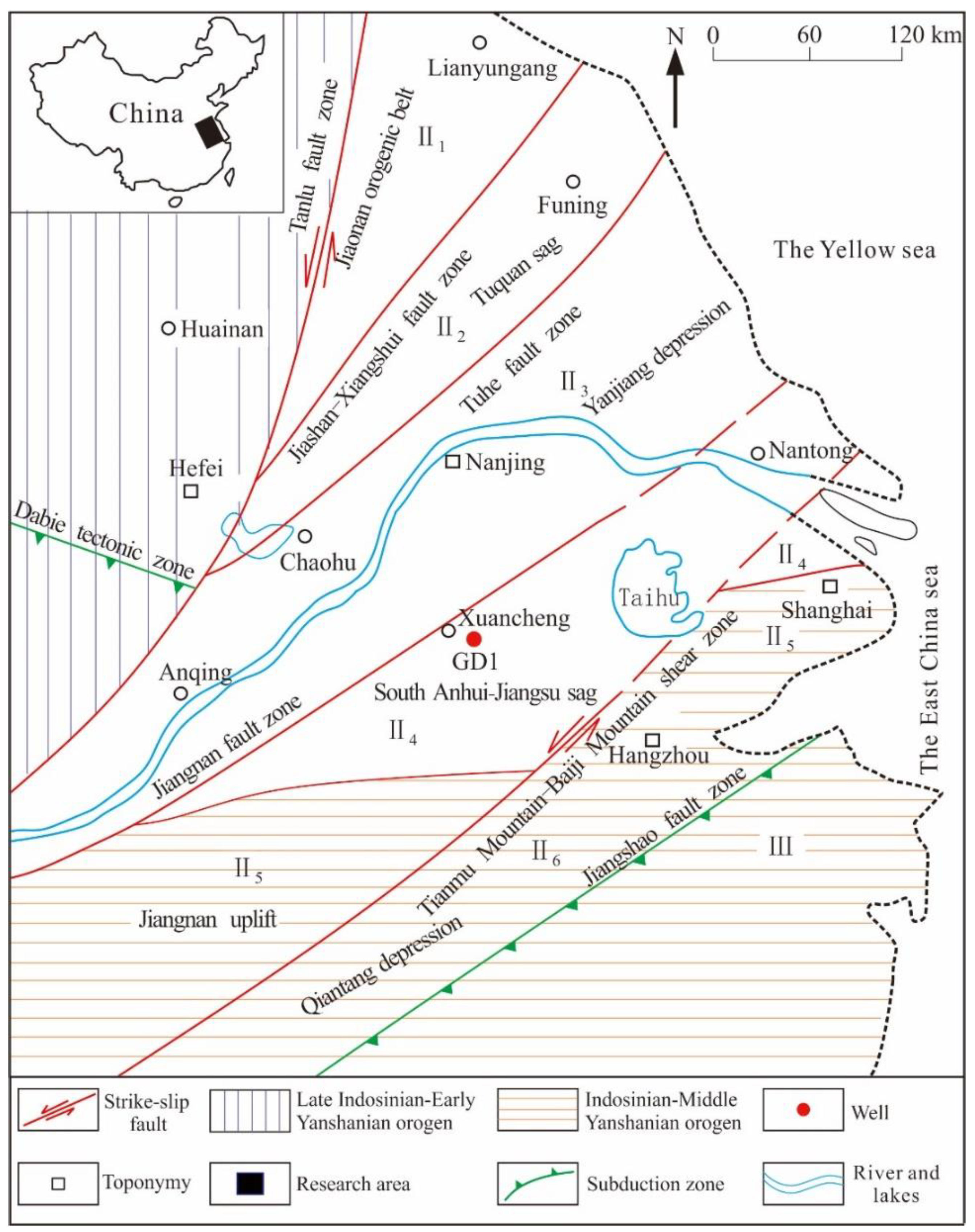
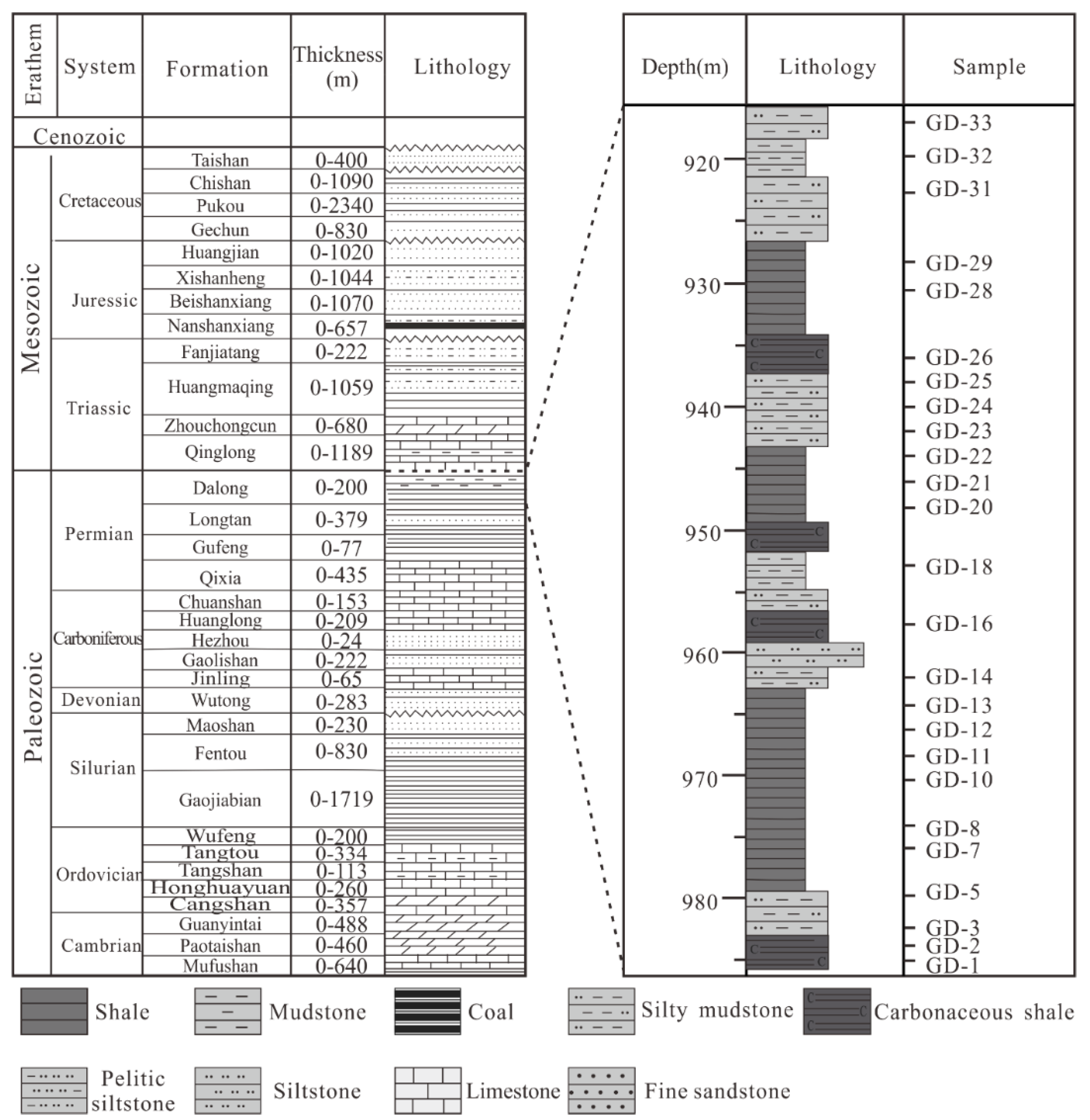
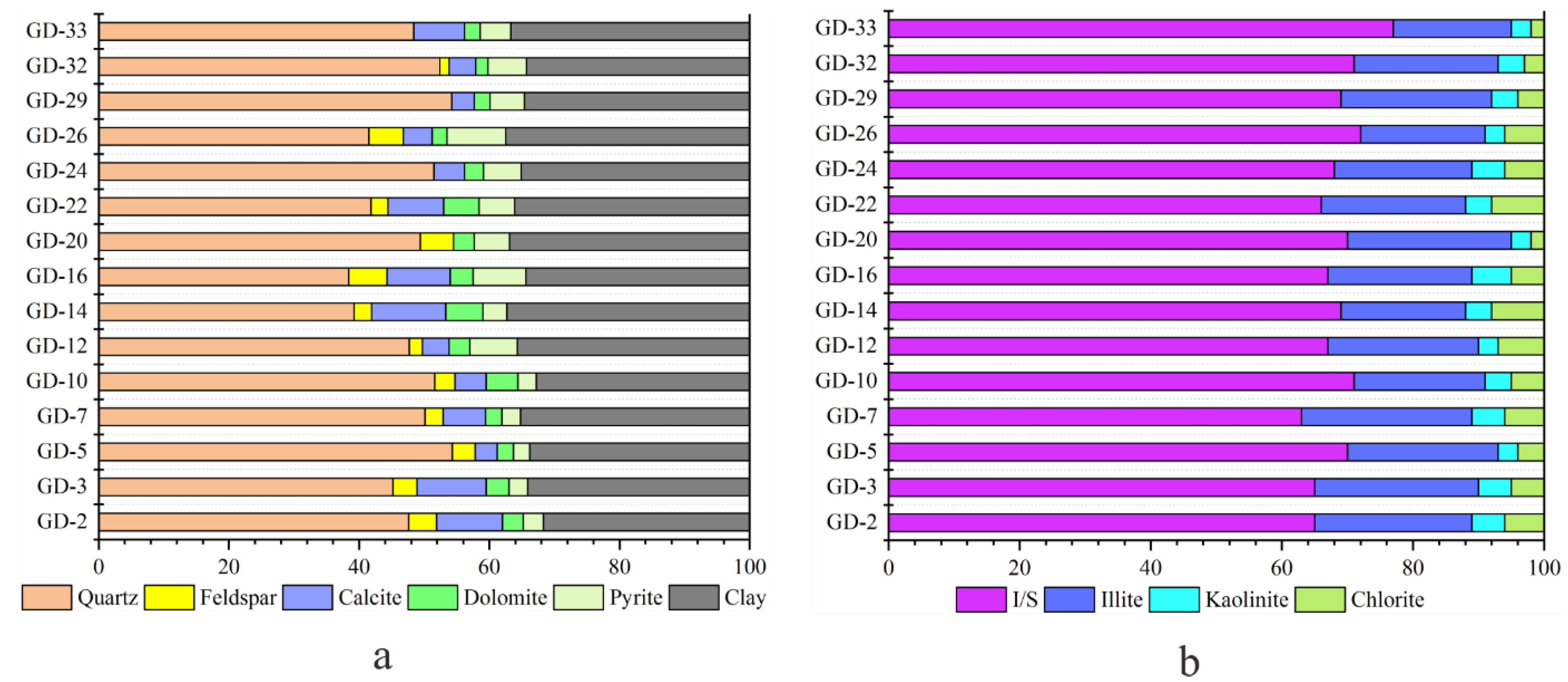
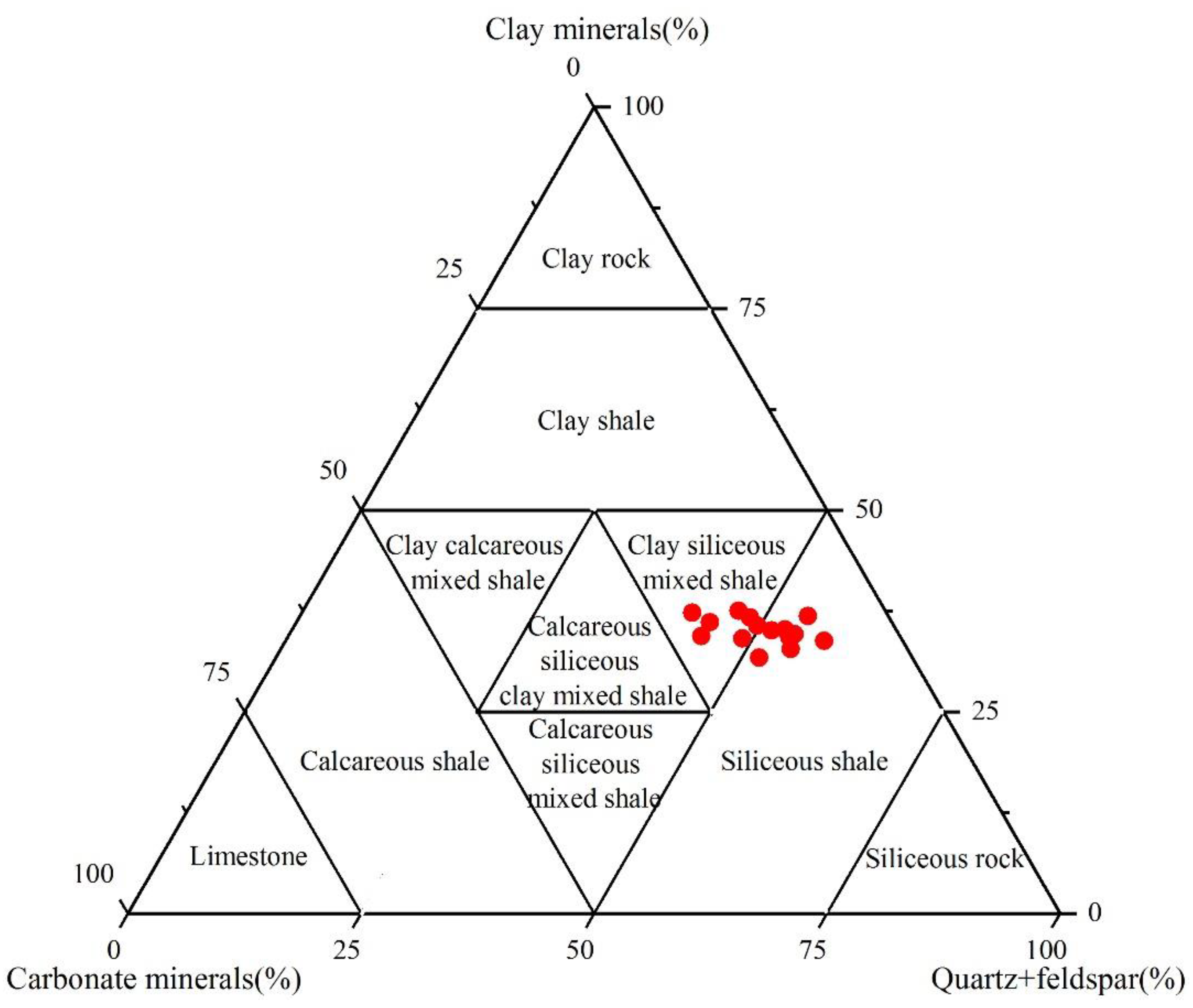

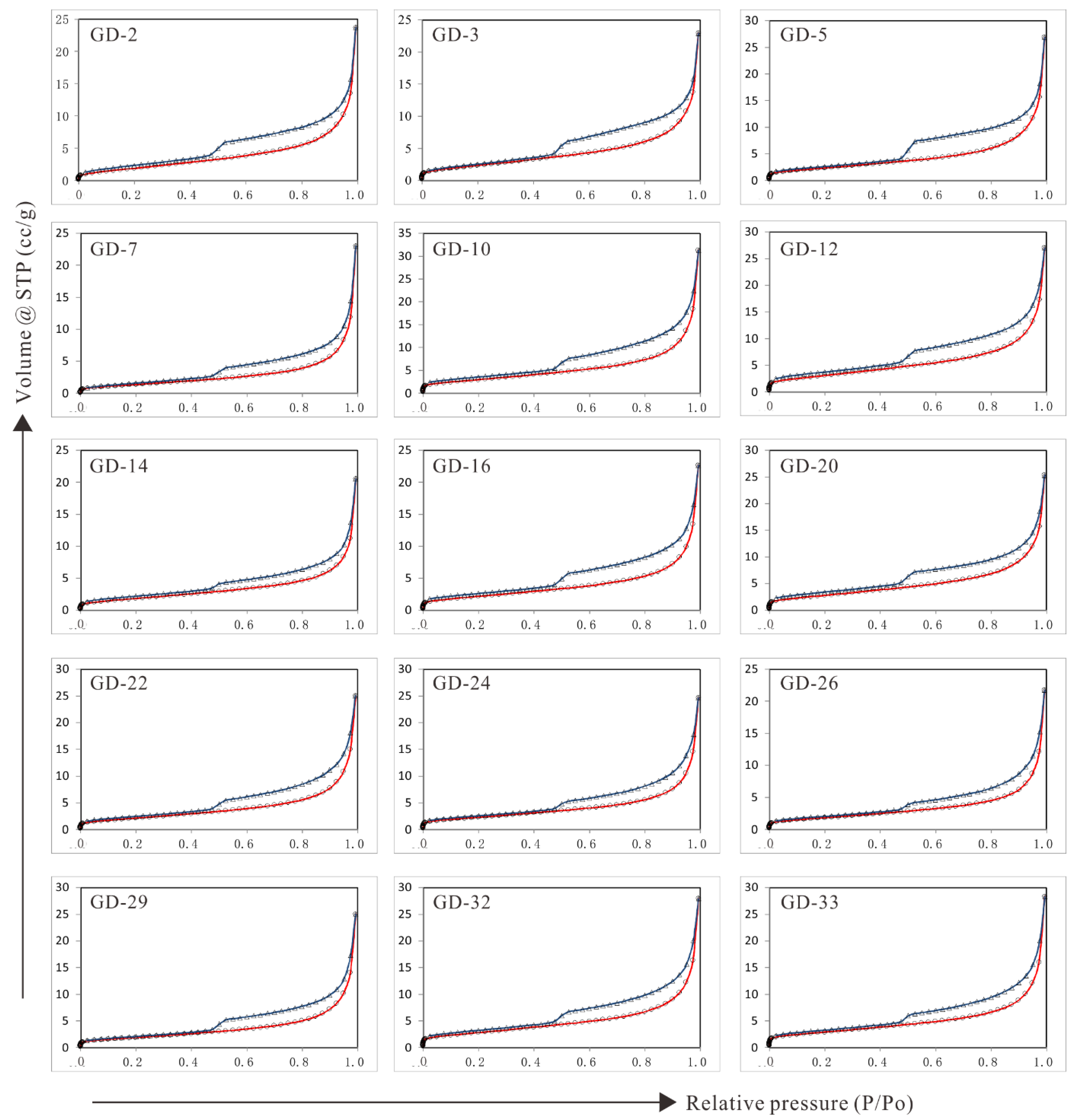
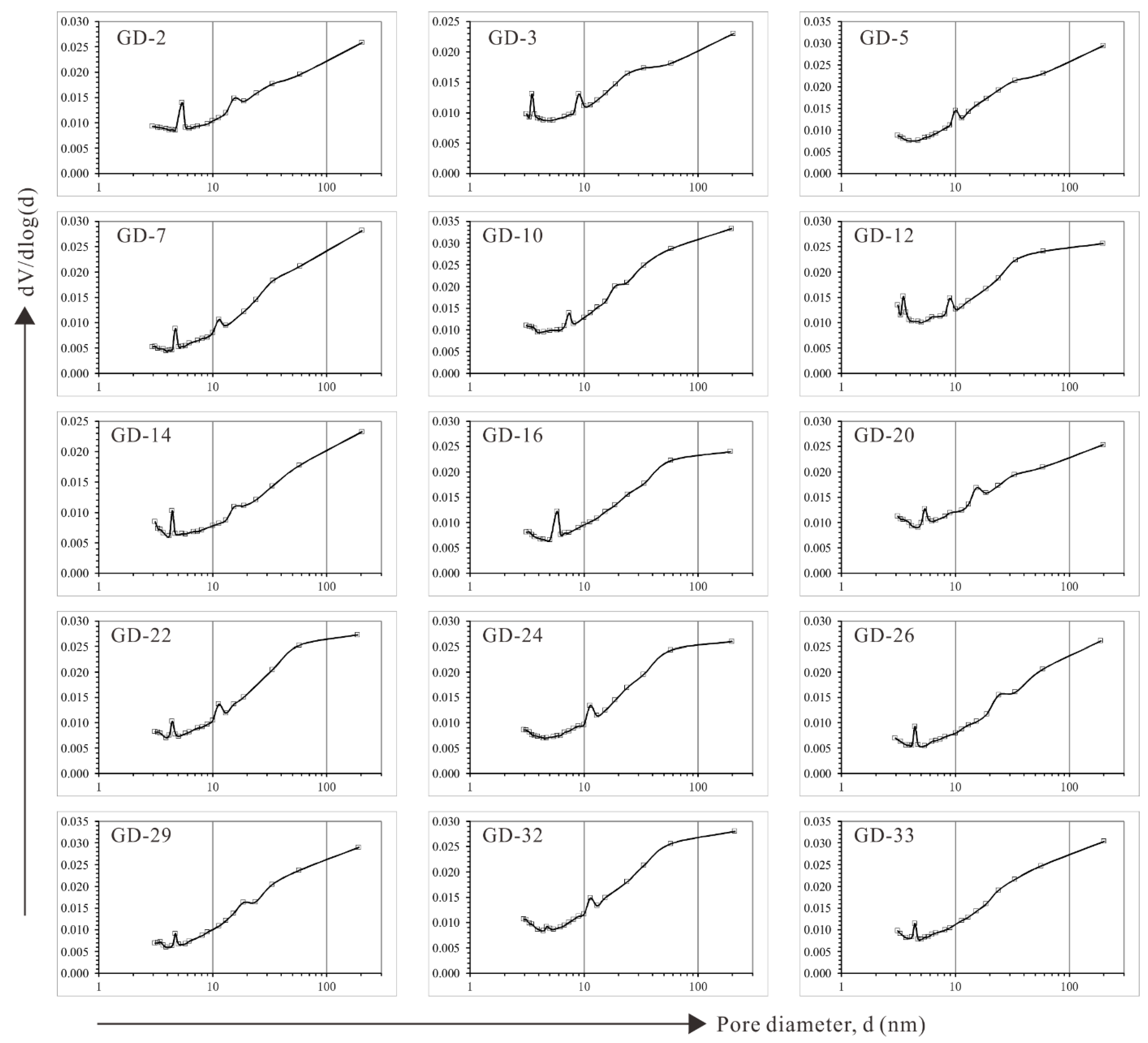
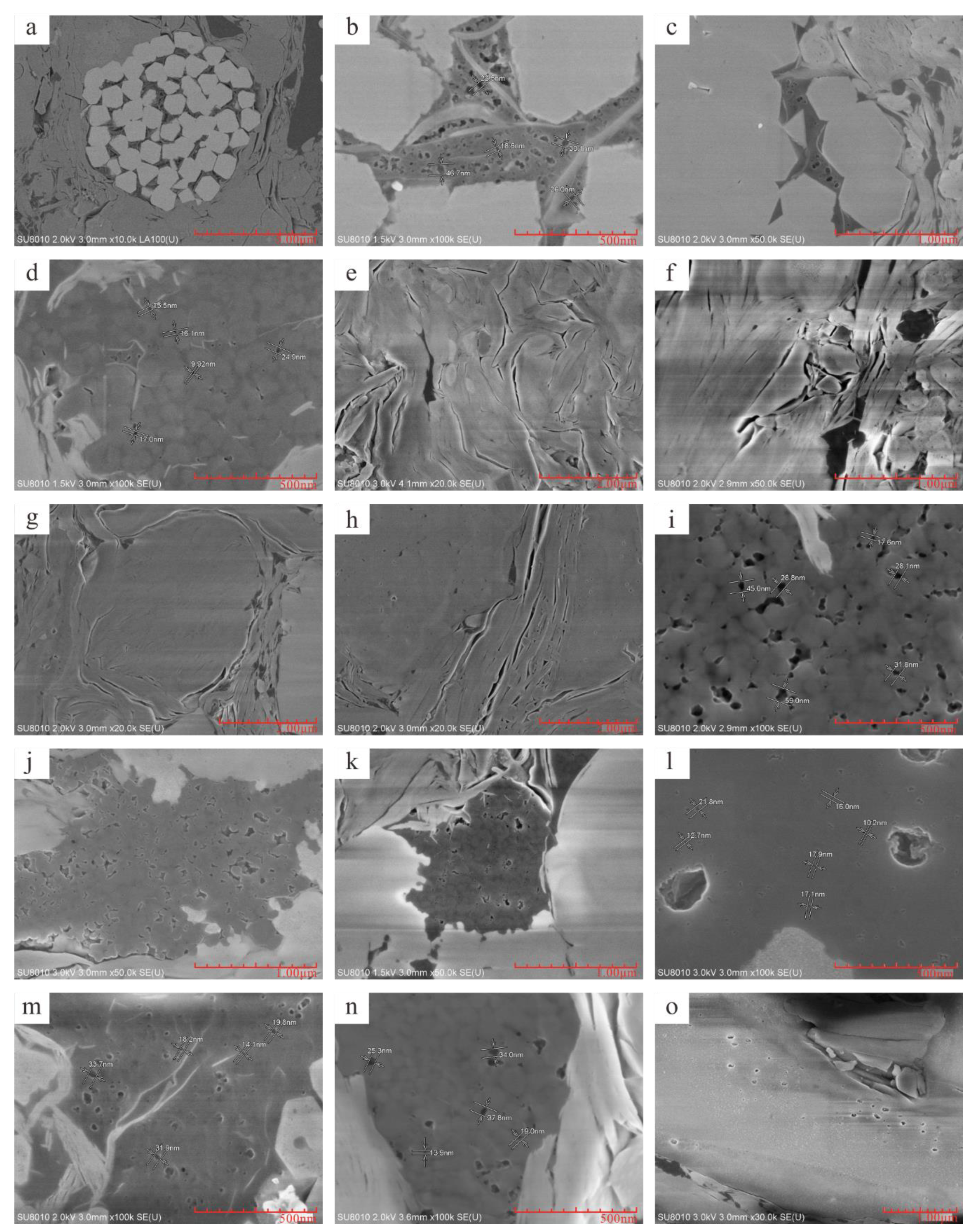
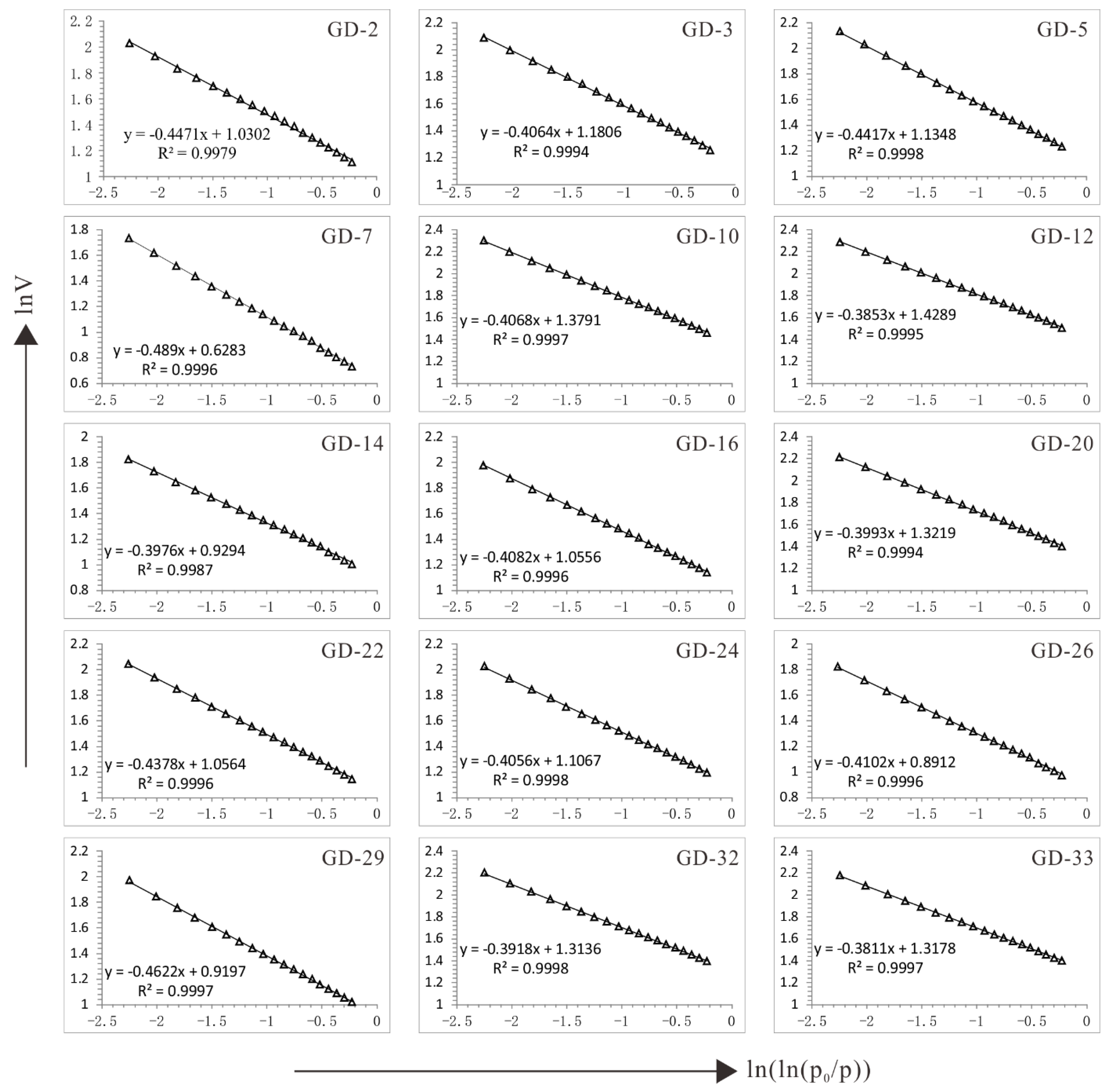
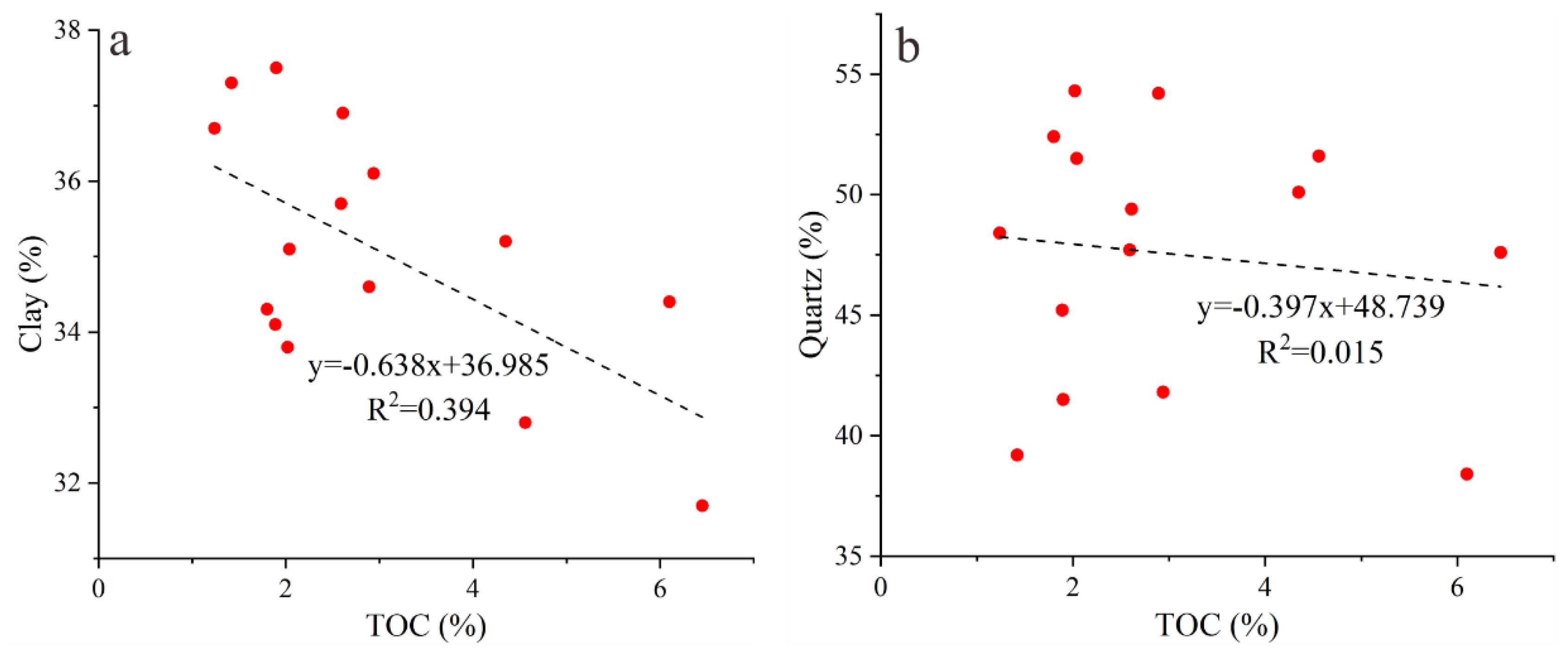
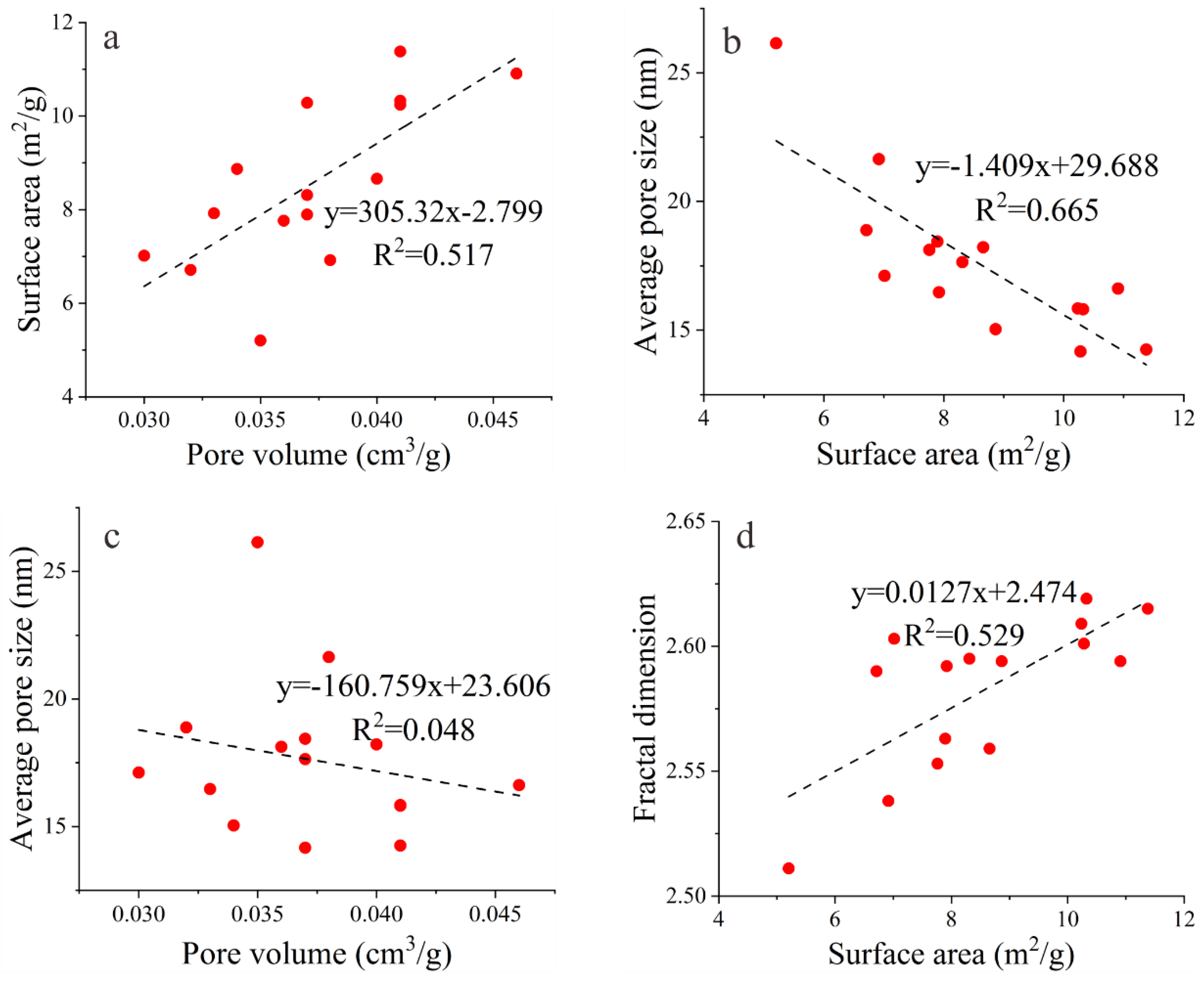
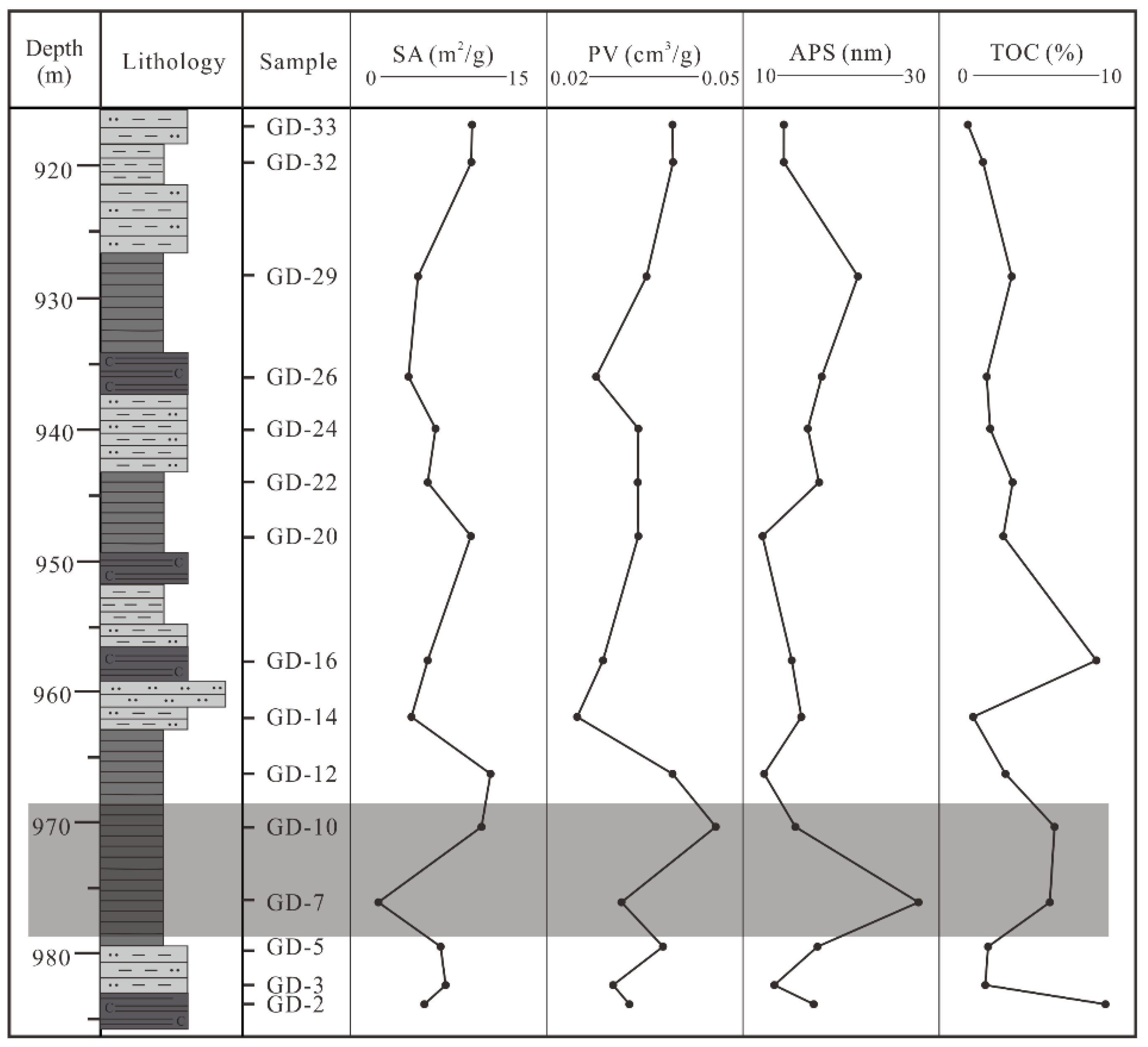
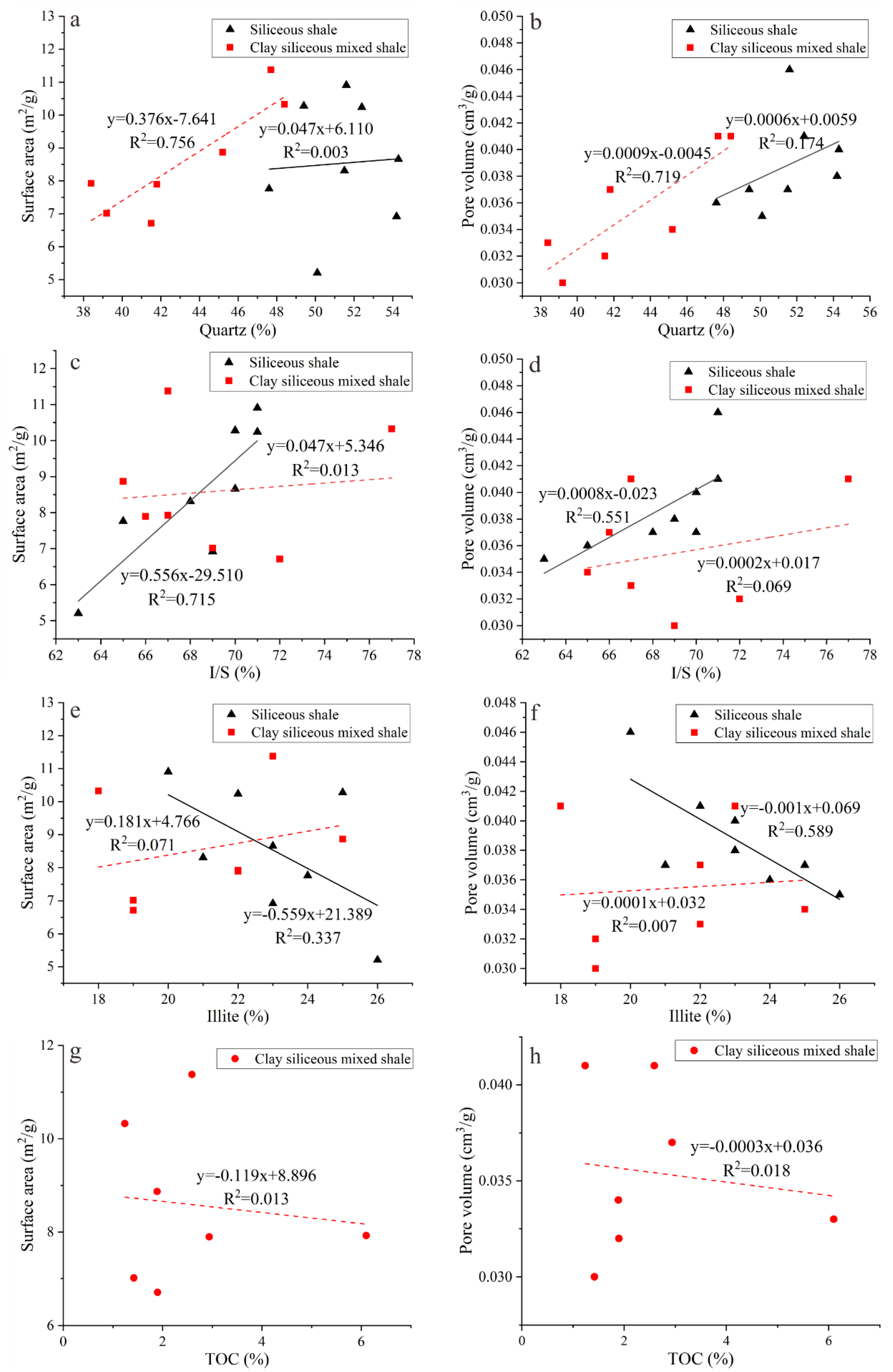
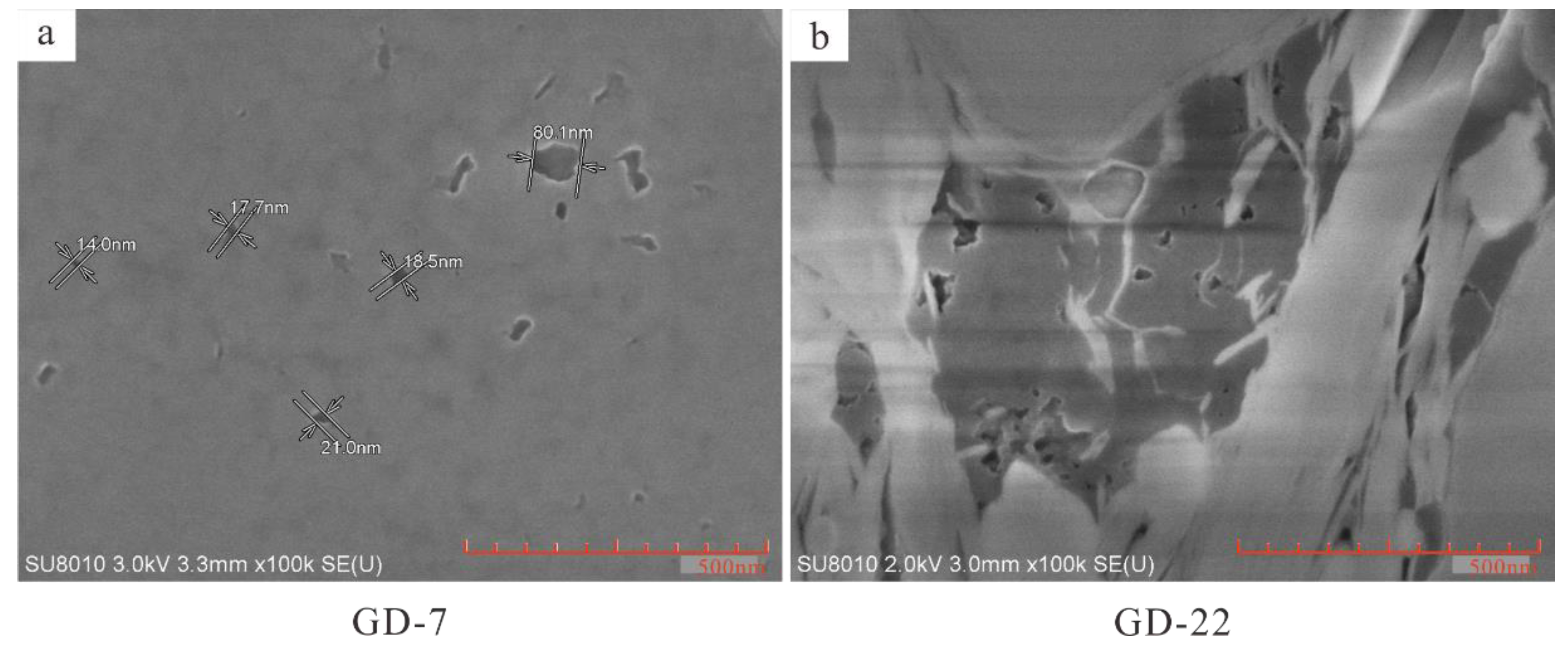

| Sample ID | Depth (m) | Maceral Composition (%) | Type Index (TI) | Kerogen Type | |||
|---|---|---|---|---|---|---|---|
| Liptinite | Exinite | Vitrinite | Inertinite | ||||
| GD-1 | 984.9 | 73.7 | 0 | 25.0 | 1.3 | 53.7 | II1 |
| GD-5 | 979.3 | 92.7 | 0 | 6.7 | 0.7 | 87.0 | I |
| GD-8 | 973.7 | 89.7 | 0 | 9.3 | 1.0 | 81.7 | I |
| GD-11 | 967.5 | 87.7 | 0 | 10.7 | 1.7 | 78.0 | II1 |
| GD-13 | 964.0 | 89.4 | 0 | 9.4 | 1.2 | 81.2 | I |
| GD-18 | 953.5 | 86.6 | 3.0 | 9.3 | 1.1 | 80.0 | I |
| GD-21 | 945.9 | 94.5 | 0 | 5.0 | 0.5 | 90.3 | I |
| GD-23 | 941.8 | 90.2 | 0 | 8.4 | 1.4 | 82.5 | I |
| GD-25 | 937.8 | 90.5 | 0 | 8.9 | 1.0 | 82.8 | I |
| GD-28 | 932.5 | 91.8 | 0 | 7.4 | 0.8 | 85.5 | I |
| GD-31 | 920.7 | 86.3 | 1.0 | 11.8 | 0.9 | 77.1 | II1 |
| Sample ID | Depth (m) | TOC (%) | Ro (%) |
|---|---|---|---|
| GD-1 | 984.9 | 3.54 | 1.29 |
| GD-2 | 983.8 | 6.45 | |
| GD-3 | 982.0 | 1.89 | |
| GD-5 | 979.3 | 2.02 | 1.20 |
| GD-7 | 975.7 | 4.35 | |
| GD-8 | 973.7 | 3.05 | 1.17 |
| GD-10 | 970.5 | 4.56 | |
| GD-11 | 967.5 | 3.68 | 1.24 |
| GD-12 | 966.8 | 2.59 | |
| GD-13 | 964.0 | 3.20 | 1.19 |
| GD-14 | 961.5 | 1.42 | |
| GD-16 | 957.2 | 6.10 | |
| GD-18 | 953.5 | 2.05 | 1.25 |
| GD-20 | 948.4 | 2.61 | |
| GD-21 | 945.9 | 2.81 | 1.15 |
| GD-22 | 944.1 | 2.94 | |
| GD-23 | 941.8 | 1.86 | 1.24 |
| GD-24 | 940.1 | 2.04 | |
| GD-25 | 937.8 | 1.70 | 1.21 |
| GD-26 | 936.6 | 1.90 | |
| GD-28 | 932.5 | 2.18 | 1.16 |
| GD-29 | 929.5 | 2.89 | |
| GD-31 | 920.7 | 1.18 | 1.24 |
| GD-32 | 918.9 | 1.80 | |
| GD-33 | 917.2 | 1.24 | |
| Average | 2.80 | 1.21 |
| Sample | Mineral Composition (%) | Clay Composition (%) | ||||||||
|---|---|---|---|---|---|---|---|---|---|---|
| Quartz | Feldspar | Calcite | Dolomite | Pyrite | Clay | I/S | Illite | Kaolinite | Chlorite | |
| GD-2 | 47.6 | 4.3 | 10.1 | 3.2 | 3.1 | 31.7 | 65 | 24 | 5 | 6 |
| GD-3 | 45.2 | 3.7 | 10.6 | 3.5 | 2.9 | 34.1 | 65 | 25 | 5 | 5 |
| GD-5 | 54.3 | 3.5 | 3.4 | 2.5 | 2.5 | 33.8 | 70 | 23 | 3 | 4 |
| GD-7 | 50.1 | 2.8 | 6.5 | 2.5 | 2.9 | 35.2 | 63 | 26 | 5 | 6 |
| GD-10 | 51.6 | 3.1 | 4.8 | 4.9 | 2.8 | 32.8 | 71 | 20 | 4 | 5 |
| GD-12 | 47.7 | 2.0 | 4.1 | 3.2 | 7.3 | 35.7 | 67 | 23 | 3 | 7 |
| GD-14 | 39.2 | 2.7 | 11.4 | 5.7 | 3.7 | 37.3 | 69 | 19 | 4 | 8 |
| GD-16 | 38.4 | 5.9 | 9.7 | 3.5 | 8.1 | 34.4 | 67 | 22 | 6 | 5 |
| GD-20 | 49.4 | 5.1 | 0 | 3.2 | 5.4 | 36.9 | 70 | 25 | 3 | 2 |
| GD-22 | 41.8 | 2.6 | 8.6 | 5.4 | 5.5 | 36.1 | 66 | 22 | 4 | 8 |
| GD-24 | 51.5 | 0 | 4.7 | 2.9 | 5.8 | 35.1 | 68 | 21 | 5 | 6 |
| GD-26 | 41.5 | 5.3 | 4.4 | 2.3 | 9.0 | 37.5 | 72 | 19 | 3 | 6 |
| GD-29 | 54.2 | 0 | 3.5 | 2.4 | 5.3 | 34.6 | 69 | 23 | 4 | 4 |
| GD-32 | 52.4 | 1.4 | 4.1 | 1.9 | 5.9 | 34.3 | 71 | 22 | 4 | 3 |
| GD-33 | 48.4 | 0 | 7.8 | 2.4 | 4.7 | 36.7 | 77 | 18 | 3 | 2 |
| Average | 47.6 | 2.8 | 6.2 | 3.3 | 5.0 | 35.1 | 68.7 | 22.1 | 4.1 | 5.1 |
| Lithofacies | Sample | SA (m²/g) | R2 (SA) | PV (cm³/g) | APS (nm) |
|---|---|---|---|---|---|
| Siliceous shale | GD-2 | 7.76 | 0.9989 | 0.036 | 18.1 |
| GD-5 | 8.66 | 0.9998 | 0.040 | 18.2 | |
| GD-7 | 5.20 | 0.9994 | 0.035 | 26.1 | |
| GD-10 | 10.91 | 0.9999 | 0.046 | 16.6 | |
| GD-20 | 10.22 | 0.9998 | 0.037 | 14.2 | |
| GD-24 | 8.31 | 0.9999 | 0.037 | 17.6 | |
| GD-29 | 6.92 | 0.9998 | 0.038 | 21.6 | |
| GD-32 | 10.24 | 0.9999 | 0.041 | 15.8 | |
| Average | 8.53 | 0.039 | 18.6 | ||
| Clay–siliceous mixed shale | GD-3 | 8.87 | 0.9997 | 0.034 | 15.0 |
| GD-12 | 11.38 | 0.9999 | 0.041 | 14.3 | |
| GD-14 | 7.02 | 0.9995 | 0.030 | 17.1 | |
| GD-16 | 7.92 | 0.9999 | 0.033 | 16.5 | |
| GD-22 | 7.90 | 0.9998 | 0.037 | 18.4 | |
| GD-26 | 6.71 | 0.9999 | 0.032 | 18.9 | |
| GD-33 | 10.32 | 0.9999 | 0.041 | 15.8 | |
| Average | 8.59 | 0.035 | 16.6 |
| Lithofacies | Sample | Fitting Equation | R2 | Prob > F | D |
|---|---|---|---|---|---|
| Siliceous shale | GD-2 | y = −0.447x + 1.030 | 0.9979 | 0 | 2.553 |
| GD -5 | y = −0.441x + 1.134 | 0.9998 | 0 | 2.559 | |
| GD-7 | y = −0.489x + 0.628 | 0.9996 | 0 | 2.511 | |
| GD-10 | y = −0.406x + 1.379 | 0.9997 | 0 | 2.594 | |
| GD-20 | y = −0.399x + 1.321 | 0.9994 | 0 | 2.601 | |
| GD-24 | y = −0.405x + 1.106 | 0.9998 | 0 | 2.595 | |
| GD-29 | y = −0.462x + 0.919 | 0.9997 | 0 | 2.538 | |
| GD-32 | y = −0.391x + 1.313 | 0.9998 | 0 | 2.609 | |
| Clay—siliceous mixed shale | GD-3 | y = −0.406x + 1.180 | 0.9994 | 0 | 2.594 |
| GD-12 | y = −0.385x +1.428 | 0.9995 | 0 | 2.615 | |
| GD-14 | y = −0.397x + 0.929 | 0.9987 | 0 | 2.603 | |
| GD-16 | y = −0.408x + 1.055 | 0.9996 | 0 | 2.592 | |
| GD-22 | y = −0.437x + 1.056 | 0.9996 | 0 | 2.563 | |
| GD-26 | y = −0.410x + 0.891 | 0.9996 | 0 | 2.590 | |
| GD-33 | y = −0.381x + 1.317 | 0.9997 | 0 | 2.619 |
© 2020 by the authors. Licensee MDPI, Basel, Switzerland. This article is an open access article distributed under the terms and conditions of the Creative Commons Attribution (CC BY) license (http://creativecommons.org/licenses/by/4.0/).
Share and Cite
Xu, L.; Zhang, J.; Ding, J.; Liu, T.; Shi, G.; Li, X.; Dang, W.; Cheng, Y.; Guo, R. Pore Structure and Fractal Characteristics of Different Shale Lithofacies in the Dalong Formation in the Western Area of the Lower Yangtze Platform. Minerals 2020, 10, 72. https://doi.org/10.3390/min10010072
Xu L, Zhang J, Ding J, Liu T, Shi G, Li X, Dang W, Cheng Y, Guo R. Pore Structure and Fractal Characteristics of Different Shale Lithofacies in the Dalong Formation in the Western Area of the Lower Yangtze Platform. Minerals. 2020; 10(1):72. https://doi.org/10.3390/min10010072
Chicago/Turabian StyleXu, Longfei, Jinchuan Zhang, Jianghui Ding, Tong Liu, Gang Shi, Xingqi Li, Wei Dang, Yishan Cheng, and Ruibo Guo. 2020. "Pore Structure and Fractal Characteristics of Different Shale Lithofacies in the Dalong Formation in the Western Area of the Lower Yangtze Platform" Minerals 10, no. 1: 72. https://doi.org/10.3390/min10010072
APA StyleXu, L., Zhang, J., Ding, J., Liu, T., Shi, G., Li, X., Dang, W., Cheng, Y., & Guo, R. (2020). Pore Structure and Fractal Characteristics of Different Shale Lithofacies in the Dalong Formation in the Western Area of the Lower Yangtze Platform. Minerals, 10(1), 72. https://doi.org/10.3390/min10010072





